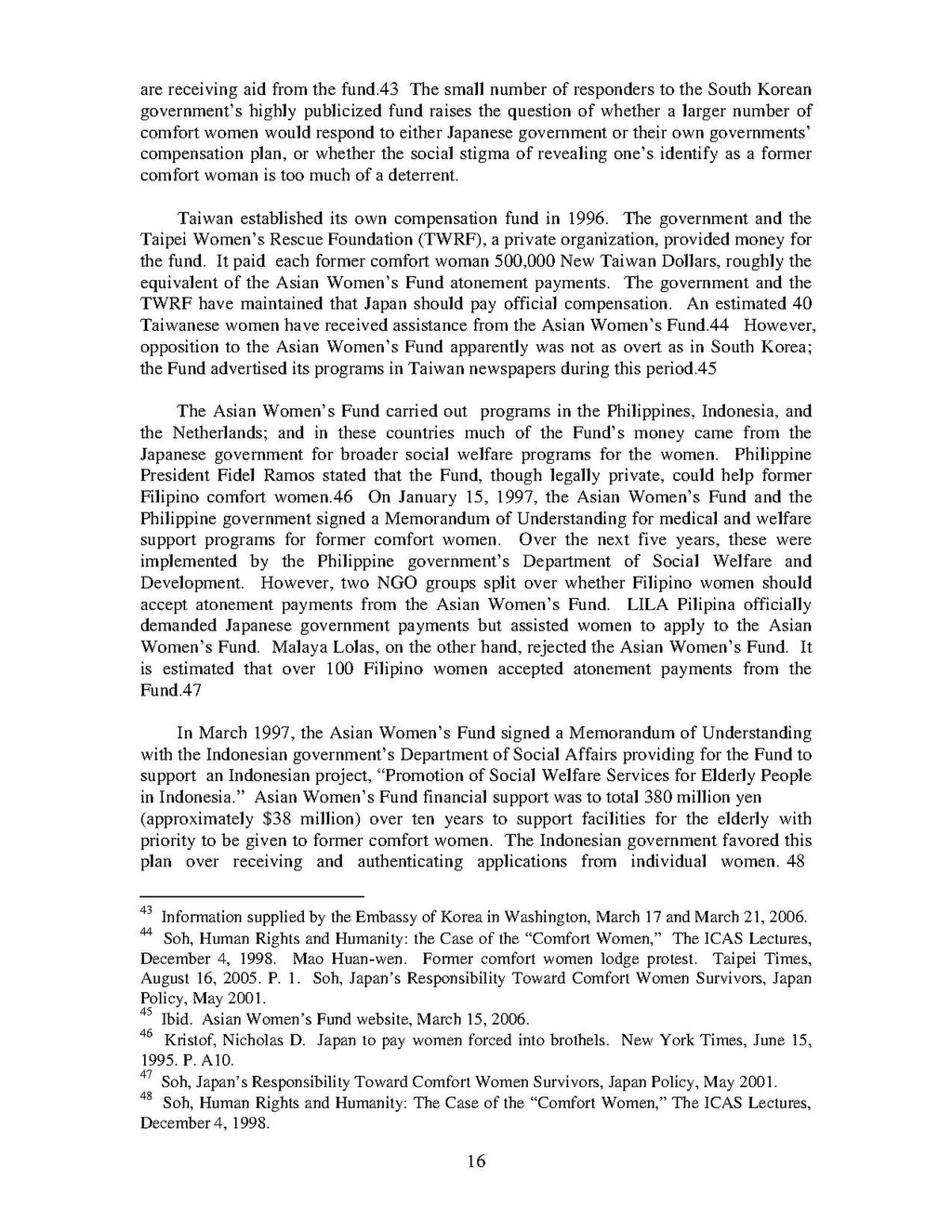are receiving aid from the fund.[1] The small number of responders to the South Korean government’s highly publicized fund raises the question of whether a larger number of comfort women would respond to either Japanese government or their own governments’ compensation plan, or whether the social stigma of revealing one’s identify as a former comfort woman is too much of a deterrent.
Taiwan established its own compensation fund in 1996. The government and the Taipei Women’s Rescue Foundation (TWRF), a private organization, provided money for the fund. It paid each former comfort woman 500,000 New Taiwan Dollars, roughly the equivalent of the Asian Women’s Fund atonement payments. The government and the TWRF have maintained that Japan should pay official compensation. An estimated 40 Taiwanese women have received assistance from the Asian Women’s Fund.[2] However, opposition to the Asian Women’s Fund apparently was not as overt as in South Korea; the Fund advertised its programs in Taiwan newspapers during this period.[3]
The Asian Women’s Fund carried out programs in the Philippines, Indonesia, and the Netherlands; and in these countries much of the Fund’s money came from the Japanese government for broader social welfare programs for the women. Philippine President Fidel Ramos stated that the Fund, though legally private, could help former Filipino comfort women.[4] On January 15, 1997, the Asian Women’s Fund and the Philippine government signed a Memorandum of Understanding for medical and welfare support programs for former comfort women. Over the next five years, these were implemented by the Philippine government’s Department of Social Welfare and Development. However, two NGO groups split over whether Filipino women should accept atonement payments from the Asian Women’s Fund. LILA Pilipina officially demanded Japanese government payments but assisted women to apply to the Asian Women’s Fund. Malaya Lolas, on the other hand, rejected the Asian Women’s Fund. It is estimated that over 100 Filipino women accepted atonement payments from the Fund.[5]
In March 1997, the Asian Women’s Fund signed a Memorandum of Understanding with the Indonesian government’s Department of Social Affairs providing for the Fund to support an Indonesian project, “Promotion of Social Welfare Services for Elderly People in Indonesia.” Asian Women’s Fund financial support was to total 380 million yen (approximately $38 million) over ten years to support facilities for the elderly with priority to be given to former comfort women. The Indonesian government favored this plan over receiving and authenticating applications from individual women.[6]
- ↑ Information supplied by the Embassy of Korea in Washington, March 17 and March 21, 2006.
- ↑ Soh, Human Rights and Humanity: the Case of the “Comfort Women,” The ICAS Lectures, December 4, 1998. Mao Huan-wen. Former comfort women lodge protest. Taipei Times, August 16, 2005. P. 1. Soh, Japan’s Responsibility Toward Comfort Women Survivors, Japan Policy, May 2001.
- ↑ Ibid. Asian Women’s Fund website, March 15, 2006.
- ↑ Kristof, Nicholas D. Japan to pay women forced into brothels. New York Times, June 15, 1995. P. A10.
- ↑ Soh, Japan’s Responsibility Toward Comfort Women Survivors, Japan Policy, May 2001.
- ↑ Soh, Human Rights and Humanity: The Case of the “Comfort Women,” The ICAS Lectures, December 4, 1998.
16
